Number of ocean plants is absolutely greater than ocean animals. As in the bottom of nutrient cycling and food chain, ocean plants have to feed food demand to creatures in the higher level of the chain. Like ocean animals, humans’ knowledge on ocean plants is rather limited. We conclude that human as a part of the earth’s ecosystem do not yet know the importance of other roles. This article give us important lesson on the ocean life particularly ocean plants.
We see further in this article that adverse effects occur to ocean particularly ocean plants. These come from human activities include among others pollution, climate change, global warming, sea transportation, exploration and exploitation inside ocean ecosystem including coastal regions throughout the world. We are afraid the adverse effects of human activities will hit humans themselves particularly the existence of human beings on the earth.
See also: oceans in the world
Types
- Phytoplankton (Phytoplankton)
 Phytoplankton are classified into Kingdom Monera. They are from the plankton community with auto-tropic or self feeding capability of producing energy from photosynthesis and chemo synthesis.
Phytoplankton are classified into Kingdom Monera. They are from the plankton community with auto-tropic or self feeding capability of producing energy from photosynthesis and chemo synthesis.
Where sunlight penetrates ocean waters, phytoplankton flow with water current. In the 200-meter depth of ocean water, phytoplankton can be found. These consist of three groups. Such as golden-brown algae, green algae and blue-green algae. Biologists gauge whether ocean water is polluted or not depend on phytoplankton’s health and abundance.
The amount rises and decreases and it depends on friendly light, temperature and minerals. Ocean pollution, climate change and global warming can terminate the life of phytoplankton. The reproduction system is through fission.
- Green Algae (Chlorophyta)
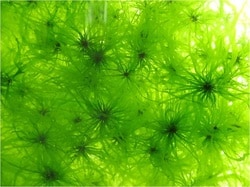 Green algae have Phylum Chlorophyta and Class Chlorophyceae. There are many species under Phylum Chlorophyta. It is mostly found in cell colonies. It is single-celled and microscopic plant. In its evolution, green algae gave rise to the first land plants. The habitat is mostly aquatic plant in freshwater and marine.
Green algae have Phylum Chlorophyta and Class Chlorophyceae. There are many species under Phylum Chlorophyta. It is mostly found in cell colonies. It is single-celled and microscopic plant. In its evolution, green algae gave rise to the first land plants. The habitat is mostly aquatic plant in freshwater and marine.
Biologists consider green algae has important position in the food chain. Thus, the primary producers give living organism usable energy by converting sunlight and inorganic chemicals. Green algae become food supply for zooplankton, for example.
Despite some grow on soil, trees or rock, those are not included Chlorophyta or chlorophytes but Trebouxiophyceae. The reproduction may be in a kind of fission (splitting), budding, fragmentation or by zoospores (motile spores). Humans take benefits from green algae, i.e. cancer drugs, aquarium and food supplement.
- Golden-brown Algae (Chrysophyceae)
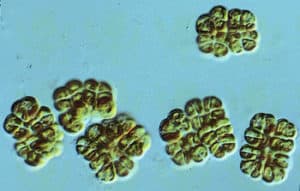 Golden-brown algae has Phylum Ochrophyta and species Chrysophyceae. These are single-celled algae with their habitat in salt and freshwater.
Golden-brown algae has Phylum Ochrophyta and species Chrysophyceae. These are single-celled algae with their habitat in salt and freshwater.
Then, the cell walls dominantly have pectin plus silica, and these make the plant rather rigid. Golden-grown algae store carbohydrate and large oil droplet as their energy.
When Golden-brown algae swim they get aids from their flagella. Golden-grown algae have photsynthetic pigments, namely chlorophylls A and C.
On the other hand, the plants are important in ocean waters for its productivity and biomass building particularly the micro fraction of the phytoplankton, namely nanoplaknton with the diameter of cells less than 0.05 mm. When dying, the shells of golden-brown algae stimulate sediment building on the sea and it is beneficial for filtration in liquid purification system.
- Blue-green Algae (Cyanobacteria)
 Blue-green algae has Phylum Bacteria and species Cyanobacteria. Blue-green algae obtain energy from photosynthesis and they are the only prokaryotic being able to produce oxygen from photosynthesis. Forbidding drinking raw water is suggested because the blue-green algae change the taste of drinking water when they undergo bloom.
Blue-green algae has Phylum Bacteria and species Cyanobacteria. Blue-green algae obtain energy from photosynthesis and they are the only prokaryotic being able to produce oxygen from photosynthesis. Forbidding drinking raw water is suggested because the blue-green algae change the taste of drinking water when they undergo bloom.
Blue-green algae is not “primary producers” for higher organism and on the contrary, these have adverse effect to other aquatic organisms. For example, the breakdown of blue-green algae bloom requires oxygen demand, and deplete oxygen for aquatic organism.
Blue-green algae cause some symptoms, such as stomach cramps, diarrhea, vomiting, headache, fever, muscle weakness, difficulty breathing.
- Red Algae (Rhodophyta)
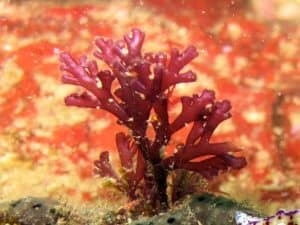 Red algae has Phylum Rhodophyta, Class Florideophyceae. Red algae are mostly marine algae. Total number of red algae reaches 4,000 species and mostly in tropical waters.
Red algae has Phylum Rhodophyta, Class Florideophyceae. Red algae are mostly marine algae. Total number of red algae reaches 4,000 species and mostly in tropical waters.
The size is diverse from microscopic to macroscopic. It is able to do photosyntehsis with their pigment. Namely chlorophylls A and D Red color from the algae comes from pigments called phycoerythrins.
When absorbing blue light in the pigments, red algae can live over 500 feet in the depth. The algae store energy in a form of lolysaccharide called floridean startch.
See also : Ocean Layers
- Brown Algae (Phaeophyceae)
 Brown algae has Division Chromophyta, Phylum Phaeophyta and Class Phaeophycea. These are multicellular algae and a group of photosynthetic protists. There are about 1,500 species of Brown algae.
Brown algae has Division Chromophyta, Phylum Phaeophyta and Class Phaeophycea. These are multicellular algae and a group of photosynthetic protists. There are about 1,500 species of Brown algae.
The algae are common in cold waters along continental coastline particularly in Northern Hemisphere. The algae are mostly found on rocky ocean shores. Their species lived in freshwater are rare. The algae multiply by asexual and sexual reproduction. Humans have benefit from brown algae, namely Algin.
Algin is a clloidal gel that has the function of stabilizer in ice cream and baking industry or eaten as a vegetable, i.e. Laminaria in some East Asian countries. Sargachromanol G in brown algae has anti-inflammatory characteristic.
- Killer Algae (Caulerpa taxifolla)
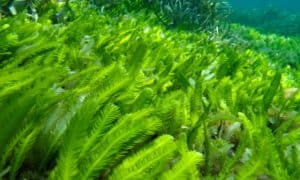 Killer algae have Kingdom Viridiplantae, Phylum Chlorophyta and Genus Caulerpa. It is found in tropical waters of Indian Ocean, Atlantic and Pacific Oceans. Why the algae are found in Mediterranean Sea and Southern California.
Killer algae have Kingdom Viridiplantae, Phylum Chlorophyta and Genus Caulerpa. It is found in tropical waters of Indian Ocean, Atlantic and Pacific Oceans. Why the algae are found in Mediterranean Sea and Southern California.
The reproduction system is by vegetative way. The algae can grow around 1 cm per day. They can form new stems and fronds. They have negative effects to environment. Their fast growth replaces the host algae and sea-grasses.
Moreover, the herbivores that feed the host algae replaced by Killer algae can be killed because the algae are highly toxic. The algae can be controlled through the coverage of Killer algae with tarps and the pumping of chlorine bleach under the coverage. However, the algae are adaptable to temperate condition. They are found in the depth of 3-30 meters.
- Yellow green Algae (Xanthophyta)
 Yellow-green algae has Domain Eukaryota, Phylum Ochrophyta and Class Xanthophyceae. Being Eukaryotic cell in single celled or colony, cellulose, pectin and silica make of their cell walls. The algae have two flagella or more for their moving. Their energy is stored in a form of carbohydrates. The pigments carotenoids and xanthrophyll make of the yellow-green color.
Yellow-green algae has Domain Eukaryota, Phylum Ochrophyta and Class Xanthophyceae. Being Eukaryotic cell in single celled or colony, cellulose, pectin and silica make of their cell walls. The algae have two flagella or more for their moving. Their energy is stored in a form of carbohydrates. The pigments carotenoids and xanthrophyll make of the yellow-green color.
Their sexual reproduction is a kind of Isogamous, Anisogamous or Oogamous. The life span is haplontic. The algae cover Yellow Sea for almost 200 square miles.
On the other hand, they are not poisonous but deplete oxygen in the sea water. The algae threatens the life of marine ecosystem. Yellow-green algae, diatoms, flagellates and coccolithophorides are important phytoplankton in the earth, and they have a great role of organic production.
- Diatoms (Phylum Bacillariophyta)
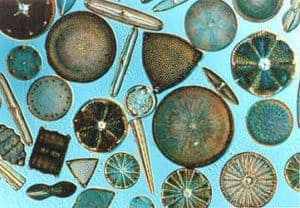 Diatoms include Kingdom Stramenopila and Phylum. The habitats are in terrestrial, marine and freshwater. The very small cell walls of Diatoms is glass like called frustules.
Diatoms include Kingdom Stramenopila and Phylum. The habitats are in terrestrial, marine and freshwater. The very small cell walls of Diatoms is glass like called frustules.
These are composed of siliica. The frustules deposits can be mined to provide diatomaceous earth for paints, cement, fertilizers, toothpaste, polishes and cleaners.
Diatomaceous can kill snails and slugs. The reproduction system is through the form of new valve (cell) walls inside the parent cells. and the new ones will be smaller than their parent.
Humans use diatoms as environmental assessment and monitoring for their tolerance to some environmental variables, such as nutrient concentration, suspended sediments, flow regime, elevation and human disturbances. Scientits will know species preferences from the interpretation of the diatom species from the past.
See also: Ocean Animals
- Dinoflagellates (Dinoflagellata)
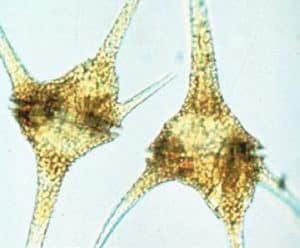 Dinoflagellates has Kingdom Alveolata and Phylum Dinoflagellata. The algae can movie with their two flagella. The algae include protozoa but their cell walls of many plates like armor make them autotrophic. The algae are called sea ghost because they can produce light over sea surface.
Dinoflagellates has Kingdom Alveolata and Phylum Dinoflagellata. The algae can movie with their two flagella. The algae include protozoa but their cell walls of many plates like armor make them autotrophic. The algae are called sea ghost because they can produce light over sea surface.
The habitat is mostly marine plankton but common in freshwater. Temperature, salinity or depth influence their population. Dinoflagellates can live in low oxygen. Some species dinoflagellates are important in the life of coral reefs for its endosymbionts with marine animals. The reproduction system involves asexual with binary fission (Desmoschisis or Eleuteroschisis).
Despite some species dinoflagellates has sexual reproduction. Dinoflagellates can produce dinotoxins. It is dangerous for fish and humans when they eat shellfish, the filter feeders with full of the toxins. For hobbyist’s aquarium, however, dinoflagellates are parasitic and predatory as well.
- Giant Kelp (Macrocystis pyrifera)
 Giant kelp has Kingdom Protista, Phylum Heterokontophyta, Class Phaeophyceae. It is found in Indian, Atlantic and Pacific ocean. It can survive in cooler waters under 21 degree Celsius. It is the largest seaweed in the world. It can grow up to 21 feet or 30 meters.
Giant kelp has Kingdom Protista, Phylum Heterokontophyta, Class Phaeophyceae. It is found in Indian, Atlantic and Pacific ocean. It can survive in cooler waters under 21 degree Celsius. It is the largest seaweed in the world. It can grow up to 21 feet or 30 meters.
The kelp forest is large and dense, and it is beneficial for marine species. Under Kingdom Protista, it is an organism with single cell, and it is the largest protist in the ocean waters. It gets nutrition from the ocean water surrounding it despite Hold-fast like a structure of Giant kelp attach it to ocean floor.
Meanwhile, the dense, large forest becomes an important ecosystem in temperate coastal areas. Ocean animals live in Giant kelp forest, such as lobsters, squid and other invertebrates. Humans produce food and chemical products from Giant kelp.
- Bull Kelp (Nereocystis leutkeana)
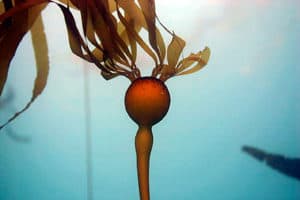 Bull kelp has Kingdom Chromalveolata, Phylum Heterokontophyta and class Phaeophyceae. It is an annual seaweed because it is able to grow fast just in one summer. It can grow up 15 inches or 25 cm in one day or 115 feet or 15 meters in size.
Bull kelp has Kingdom Chromalveolata, Phylum Heterokontophyta and class Phaeophyceae. It is an annual seaweed because it is able to grow fast just in one summer. It can grow up 15 inches or 25 cm in one day or 115 feet or 15 meters in size.
The habitats are Pacific coast from Alaska to southern California. It produces spore patches or sori. Due to its heavy it falls into ocean floor. It can establish bull kelp forest. It is dying by winter. When life it becomes protective shelter for fishes and many invertebrates, like crabs, and food source on ocean floor.
Then, when die it is a food source and beach shelter for some ocean animals, like scavenging amphipods. It can create kelp beds for a resting area of ocean animals, such as otters, waterfowl. Moreover, it reduces erosion on the beach.
- Irish Moss (Chondrus crispus)
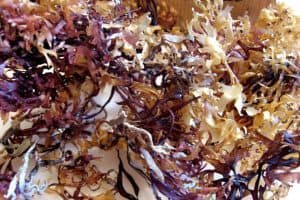 Irish moss has Kingdom Protista, Phylum Rhodophyta and Class Rhodophyceae. It grows in Atlantic coast particularly in coastline water of North America and Europe. It is also called read seaweed with flattened blades. It can grows up to 2-6 inches in tall and 4 inches in wide.
Irish moss has Kingdom Protista, Phylum Rhodophyta and Class Rhodophyceae. It grows in Atlantic coast particularly in coastline water of North America and Europe. It is also called read seaweed with flattened blades. It can grows up to 2-6 inches in tall and 4 inches in wide.
Despite it is deep purplish red color, Irish moss may have white, brown or green color. It is mostly found in inter-tidal zone and below the rock-weeds and above the kelp. It can grow well in dry condition and high humidity.
In ecosystem, it grow from seeds. The seed germinates around 7-28 days. It is easy to care. Humans use Irish mosh as food ingredient and dairy products. People in New England use it as an extract called Narraganset.
- Neptune grass (Poseidonia oceanica)
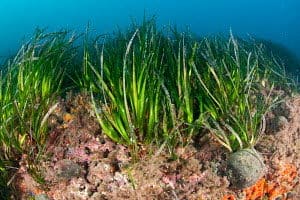 Neptune grass has Kingdom Plantae, Phylum Tracheophyta, Family Posidoniaceae. It is a plant with marine flower, and has endemic in the Mediterranean Sea. It’s favorite zone in sheltered coastal waters. As a primary producer and stabilizer in the seabed, it becomes habitat for other marine organisms.
Neptune grass has Kingdom Plantae, Phylum Tracheophyta, Family Posidoniaceae. It is a plant with marine flower, and has endemic in the Mediterranean Sea. It’s favorite zone in sheltered coastal waters. As a primary producer and stabilizer in the seabed, it becomes habitat for other marine organisms.
In the habitat, it maintains the ecosystems. The plant is relatively slowly rapid growth. When the population are rapidly decreasing due to human activities, such as coastal construction, fish farming, climate change, and it does not recover immediately.
The reproduction system is that male and female flowers produce in the same inflorescence. The habitat extends in the western Mediterranean from France, Italy to the Andalusian region and Greece, Montenegrin region, Malta, Turkey and Algeria.
- Sea Lettuce (Ulva lactuca)
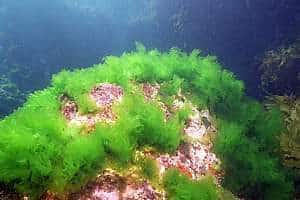 Sea lettuce has Phylum Chlorophyta and Family Ulvaceae. It is a algae or a green seaweed throughout the world. Sheltered rocks and shores along inter-tidal coastline water are its favorite habitat. It can grow in the mouths of rivers, run-off pipes and streams. However, when growing around run-off pipes, product from Ulva lactuca is not recommended. Sea lettuce is commonly found along the Irish Shoreline. In its growth it is attached to rocks. It grows up to 45 cm in the length and 30 cm across. Humans use it for cooking ingredients and herbal, such as the treatment of burn and gout, source of iodine and astringet.
Sea lettuce has Phylum Chlorophyta and Family Ulvaceae. It is a algae or a green seaweed throughout the world. Sheltered rocks and shores along inter-tidal coastline water are its favorite habitat. It can grow in the mouths of rivers, run-off pipes and streams. However, when growing around run-off pipes, product from Ulva lactuca is not recommended. Sea lettuce is commonly found along the Irish Shoreline. In its growth it is attached to rocks. It grows up to 45 cm in the length and 30 cm across. Humans use it for cooking ingredients and herbal, such as the treatment of burn and gout, source of iodine and astringet.
Like any plant with supporting condition, it reproduces in a great number. There are ten species found in cool water around the world. Of ten species, Ulva lactuca is the most known in the world.
- Eelgrass (Zostera Marina)
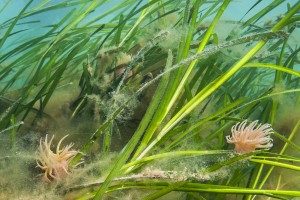 Plantae, Phylum Tracheophyta and Family Zosteraceae. Eelgras is a blooming underwater grass. It spread by rhizomes or roots. The reproduction system is by meadows. It grows in spring and summer. When dying it occurs in the fall and winter.
Plantae, Phylum Tracheophyta and Family Zosteraceae. Eelgras is a blooming underwater grass. It spread by rhizomes or roots. The reproduction system is by meadows. It grows in spring and summer. When dying it occurs in the fall and winter.
Eelgrass meadows provides food and shelter for sea animals, like Salmon, crab. The habitat is muddy, sandy bottoms of ocean floor, and it lives on shallow sub-tidal wave. It spreads in northern latitudes, i.e. north, Atlantic and north Pacific ocean. The destructed habitat will threaten the life of fish, Salmon, shellfish and other ocean animals.
When stabil, it maintains shorelines from erosion. Blade of Eelgrass’s leaves provide food for diatoms, bacteria and detrius. When dying Eelgrass’s leaves feed bacteria and fungi breaking them into tiny bits for nutrients in nearshore food chain.
- Zooxanthellae (Symbiodinium sp)
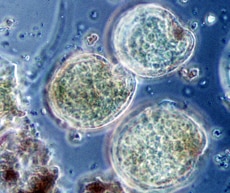 Zooxanthellae have Phylum Dinoflagellate, Genus Symbiodinium and Genus Amphidinium. Zooxanthellae lives on corals. It builds coral reef. Between coral and algae there is mutualistic relationship. The coral gives zooxanthellae a protected environment. Then, it produces oxygen and the coral can remove wastes. It contributes glucose, glycerol and amino acids to the coral.
Zooxanthellae have Phylum Dinoflagellate, Genus Symbiodinium and Genus Amphidinium. Zooxanthellae lives on corals. It builds coral reef. Between coral and algae there is mutualistic relationship. The coral gives zooxanthellae a protected environment. Then, it produces oxygen and the coral can remove wastes. It contributes glucose, glycerol and amino acids to the coral.
All of the compounds are the products of photosynthesis. Zooxanthellae is an algae and on the coral it gives pigmentation. Zooxanthellae are an algae with single cell. With its mutual relationship to coral, it also has symbiosis with various marine invertebrates, such as jellyfish.
Meanwhile, the algae does not survive with temperature changes whether it is rise or decline because a coral bleaching event can occur.
- Grey Mangroves (Avicennia marina)
 Grey mangrove has Kingdom Plantae, Family Avicenniaceae and its species name Avicennia marina. It is commonly found in the coastline of Australia, New Zealand, east Africa, south-west, south and southeast Asia particularly around intertidal zones in estuarine areas.
Grey mangrove has Kingdom Plantae, Family Avicenniaceae and its species name Avicennia marina. It is commonly found in the coastline of Australia, New Zealand, east Africa, south-west, south and southeast Asia particularly around intertidal zones in estuarine areas.
The reproduction process occurs with pale. It differs from other mangrove species in a kind of flower size, margins of calyx lobes, style shape, fruit shape, leaf apex shape and bark color. Grey mangrove is considered to have high tolerance to extreme salt. It also withstand short periods of inundation by freshwater or hypersaline water (salinity exceeding that of seawater).
On the other hand, it has economic value from its timber for boat and firewood, leaves (the best fodder for camel) and roots and bark as stimulant. It provide cyster culture as well.
- Red Mangroves (Rhizophora mangle)
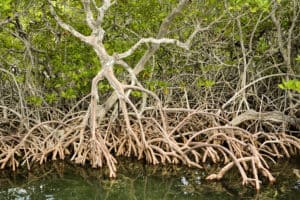 Red mangrove is a part of Kingdom Plantae Phylum Tracheophyta. It has Species name Rhizophora mangle. The habitat is in tropical and sub-tropical coastal and estuarine region and the dominant in Indo-Pacific region, Atlantic and Gulf coasts of US.
Red mangrove is a part of Kingdom Plantae Phylum Tracheophyta. It has Species name Rhizophora mangle. The habitat is in tropical and sub-tropical coastal and estuarine region and the dominant in Indo-Pacific region, Atlantic and Gulf coasts of US.
The distribution is similar to coral reefs, and it has 35 species and 60 species of mangrove associates or more. It differs from other mangroves from its prop roots and fruits. The reproduction is through propagules. Red mangrove can grow normally if it meets hyrological factors and nutrient supply plus temperature.
Mangrove crab, the mangrove land crab, coffee bean snail and the ladder horn snail are the main consumer of red mangroves. The plant has two common enemies, i.e. habitat destruction and ocean pollution.
- Coccolithophorides (Coccosphaerales)
Coccolithophores are marine plants with one cell lived in the upper layers of the ocean in great numbers. Limestone or calcile covers the microscopic plating. Their scales called coccoliths and surrounded by at least 30 scales have hubcap-like form. The coccoliths dump around 1.4 billion kilograms of calcite per year. The algae becomes the biggest calcite producers in the earth’s oceans. The algae lives on ocean surface with scarce nutrient water in temperate condition. So, they do not compete with other algae to live. Moreover, they are source of nutrition in water with rare nutrition Coccolithophores live in Indian, Atlantic and Pacific Ocean from Australia, Iceland to Bering Sea. Concerning global climate, coccolithophores have role by increasing the oceans’ albedo, i.e. the fraction of sunlight on object reflects. It occurs when the algae blooms. They contributes greenhouse gas as well.
Other Ocean Plants
For the next ten ocean plants we discuss mangroves by ecoregions. Ecoregion is an area with distinct ecology and geography. It is smaller than an bioregion. However, bioregion is smaller than an ecozone. Ecozone itself is lesser or greater than ecosystem. However, ecoregion has a specific characteristics of natural communities and species in large area of land or water. The specific characteristics relate to the biodiversity of flora, fauna and ecosystem, and it differs from other ecoregions. There are five ecoregions of mangroves, i.e. Afrotropic, Australasian, Indomalayan, Neotropic. In the following points we select some mangroves from these ecoregions.
- Central African Mangroves Ecoregion
It includes Central African mangroves ecoregion. The location covers mangrove swamps along coasts of West Africa particularly in Nigeria, Cameroon, Equatorial Guinea/Gabon, Ghana, Democratic Republic of Congo and northern Angola. Red mangrove (Rhizophora mangle), Rhizophora racemosa, and Rhizophora harrisonii, black mangrove (Avicennia germinans) and white mangrove (Laguncularia racemosa) grow in the ecoregion. Palm Nypa fruticans introduced from Asia also grows here.
Fauna are found here, such as monkeys, African manatee (Trichechus senegalensis), and turtles and birds. Threats come from human population here, particularly in Nigeria. The governments in the ecoregion should preserve the mangrove ecoregion through laws and regulation, law enforcement and reforestration.
- East African Mangroves Ecoregion
There are two varieties of mangroves in the ecoregion, i.e. the mangroves on the coast fed from streams of fresh water and the mangroves in river inlets. World Wildlife Fund considers species diversity of the mangroves is relatively low than that in Southeast Asia. The ecoregion covers Eastern African Coast, Mozambique, Somalia, Tanzania, Kenya and western coast of Madagascar.
On the other hand, the mangrove swamps are along Indian Ocean coast of East Africa. World Wildlife Fund considers the ecoregion in critical/endangered conservation status. The mangrove forests convert to salt pans, aquaculture, urbanisation and mostly rice farms. Untreated wastes flow the ecoregion. Oil and industrial pollution, silt and pesticide are discharged here.
- Madagascar Mangroves Ecoregion
It is a coastal ecoregion along western coast of Madagascar. World Wife Foundation considers the productivity is significant in ecology and biogeography. There are two species of Madagascar mangroves, i.e. Sonneratia alba and Avicennia marina. Fauna lives in the mangroves forest, such as Madagascar fish-eagle (Haliaeetus vociferoides) and the Madagascar heron (Ardea humbloti).
Meanwhile, the forest is home for Madagascar fish eagle. It gets the WWF’s Global 200 list of most outstanding ecoregion. The above flora are rare fishes and birds. The local governments protect the ecoregion. However, the international conservation organizations consider the government’s protection is relatively low impact from urban development, over fishing activities and other humans activities.
- New Guinea Mangroves Ecoregion
The ecoregion is located in the river mouth of Fly River and Sepik River covering total area of 26,800 square km. New Guinea mangrove ecoregion creates a mix of brackish water. The total area extends along the coastline of New Guinea and the large island in West of Pacific Ocean.
The mangrove ecoregion of New Guinea and Indonesia is considered the largest in the world. Humans do not have any intervention in the ecoregion. There are more than 30 species recorded from local mangrove swamp. Mangroves grow here included Avicennia alba, Avicennia marina, Rhizophora apiculata, Bruguiera parviflora and Bruguiera gymnorrhiza. Fauna species are mostly found here, i.e. Black palm cockatoo (Probosciger aterimus), Papuan hanging-parrot (Loriculus aurantiifrons),
- New Zealand Mangroves Ecoregion
New Zealand mangroves ecoregion is located in between 34 and 38 degrees south of New Zealand. The dominant species here is Avicennia marina particularly the local species, i.e. Avicennia marina var. Australasica. Avicennia marina subsp. australasica has Family Acanthaceae. It is included the plant family Acanthaceae. The species and the same species has been in New Zealand for 19 million years. The location is an intertidal zones of estuarine areas. The mangrove spreads to the south. Avicennia forests becomes marine food chainfor several marine organisms here. The habitat is from North Island from Parengarenga Harbour south to Kawhia and Ohiwa Harbours to Australia.
- Godavari-Krishna Mangroves Ecoregion
Godavari-Krishna mangroves grow in the ecoregion of Krishna River Delta and Godavari River delta located in the eastern coast of India. Total land area of the ecoregion reaches 7,000 square km from Orissa State to Tamil Nadu.
The biggest mangrove is in the two deltas. The dominant species of mangrove are Avicennia marina, Suaeda spp, Rhizophora spp, and Bruguiera spp. Saltwater crocodiles, insects, molluscs, shrimp, crabs and fish plus 140 bird species including lesser florican (Eupododits indica) and aquatic birds, such as flamingoes (Phoenicoptreus spp) makes the ecoregion as the home.
There are some Indian national parks here, i.e. Point Calimere Wildlife and Bird Sanctuary, Pulicat Lake Bird Sanctuary and Bhitarkanika National Park.
- Indochina Mangroves Ecoregion
Indochina mangroves ecoregion is located in the coasts of some Southeast Asian countries, i.e. Thailand, Vietnam and Cambodia. The largest ecoregion of Indochina mangrove are in Mekong delta and Ca Mau Province. Total coastal area reaches 10,400 square miles. The dominant species of mangrove here are Avicennia alba, Rhizophora apiculata and Bruguiera parviflora. World Wildlife Fund classifies Indonechina mangroves in the list of endangered and invasive mangroves.
There are some protected areas of Indochina mangroves here, i.e. Can Gio Mangrove Biosphere Reserve, Chalerm Pra Kiet Somdej Prathep Rattana Rachasuda Sanctuary Wildlife Sanctuary, Namtok Phlew National Park, Thale Noi Non-hunting Area and Thale Sap.
- Sunda Shelf Mangroves Ecoregion
Sunda Shelf Mangroves Ecoregion is located in Borneo and eastern region of Sumatra. The dominant mangrove species include Avicennia and Sonneratia species on the coast, Rhizophoras and Bruguieras in the swampy area. The ecoreegion becomes the home of proboscis monkey and many species of bird. Total land area reaches 14,200 square miles.
World Wildlife Fund classifies the ecoregion in the list of critical/endangered mangrove. Human activities becomes the dominant threat to the preservation of the mangrove ecoregion. There are some protected areas in the ecoregion, such as Muara Kendawangan, Tanjung Penghujan, Tanjung Puting, Bukit Tangkiling, Danau Semayang Sungay Mahakam, Kutai and Muara Kaman Sedulang.
- Sundarbans Mangroves Ecoregion
The ecoregion is located in Indo-Malayanan with total land area of 7,900 square miles. It lies in the vast delta occured for the confluence of some rivers, i.e. Ganges, Brahmaputra and Meghna river. UNESCO considers the Sundarbans Mangroves ecoregion as the world’s largest mangrove ecosystem.
Tiger (Panthera tigris) makes the mangrove ecoregion as the home. The preys include chital deer (Cervus axis), barking deer (Muntiacus muntjak), wild pig (Sus scrofal) and macaques (Macaca mulatta). World Wildlife Fundincludes the ecoregion in the list of Critical/ Endangered Mangrove. The ecoregion extends to southern Blangadesh and India’s West Bengal State. Devastating cyclone causes great damage to the ecoregion. It occurs from June to September.
- Alvarado Mangroves Ecoregion
The Alvarado Mangroves Ecoregion located in South of Mexico has total area of 600 sq. miles. It include mangrove swamps with its reef beds and palm forests. There are some coastal formations here: estuaries, mangroves, coastal dunes, lagoons and marshes. Habitats in the swaps are rays, fish and invertebrates.
On the mangrove trees, there are many species of birds that seek shelter in the branches of the mangroves and fly from tree to tree, such as keel-billed toucan, reddish egret, wood stork, herons and kingfishers. Some mammalians live here from spider monkeys to West Indian manatees. The dominant mangroove species are Rhizophora mangle, Avicennia germinans, and Laguncularia racemosa. Human activities threaten the mangroves ecoregion from water pollution, timber logging to fires.
- Bahia Mangroves Ecoregion
Located in Northeastern Brazil with total area of 800 square miles or 2,100 square km, Bahia mangroves ecoregion is a mix of tropical ecoregion between Mangrove forest biome and South American Atlantic Forest biome. There are minor bays, estuaries and river inlet.
The mangrove species here are red mangrove (Rhizophora mangle) of the Rhizophoraceae, the black mangrove (Avicennia germinans) of the Acanthaceae, and white mangrove (Laguncularia racemosa) of Combretaceae family. The mangrove ecoregion is the place of Endemic Bird Area. The Bahia mangroves ecoregion is under critical condition for human’s clearing activities to the forest, coastal urban sprawl and shrim farms in Salinas da Margaridas.
- Greater Antilles Mangroves Ecoregion
Greater Antilles Mangroves ecoregion is located on large islands of Cuba, Hispaniola, Jamaica, and Puerto Rico in Carribean shores. It prevents tropical storms and hurricanes hit the coastal area. It is barriers against salinization of coastal soils and ground water as well. Cuban Mangrove forest has four dominants species, namely Rhizophora mangle (Red mangrove), Avicennia germinans (Black mangrove), Laguncularia racemosa (White mangrove) and Conocarpus erectus (Button mangrove). Cuban crocodile Crocodylus rhombifer is the habitat of the ecoregion on the Zapata peninsula of Cuba. Mangroves growing in Discovery Bay, Jamaica have the habitat of algae and molluscs. The ecoregion supports various plants and animals that attach to mangrove roots. The birds in the ecoregion includethe Cuban Green Woodpecker Xiphidiopicus percussus, the Jamaican tody Todus todus, and Dendroica petechia gundlachi, and the clapper rail Rallus longirostris caribaeus.
- Northern Honduras Mangroves Ecoregion
Northern Honduras mangroves ecoregion is located along Caribbean coastline of Honduras. It has the border of Bahia de Amatique in Guatemala in the east. It reaches the delta of the Patuca River. Total area covers 1,036 square km. The habitats in the ecoregion are flooded savannas, marshes, lakes, mangroves, rocky beaches, coral reefs, and lagoons.
The mangrove species here are dominantly red mangrove (Rhizopora mangle), black mangrove (Avicennia germinans), white mangrove (Laguncularia racemosa), buttonwood (Conocarpus erectus) and another species of red mangrove (R. harrisonii), the leather fern (Acrostichum sp) as well as Coccolaba uvifera and Cocos nucifera. Human activities threaten the ecoregion from agriculture activities and livestock production.
- Amapa Mangroves Ecoregion
Amapa mangroves ecoregion is zone of transition between several ecosystems. The first ecosystem comprises flooded forests and grasslands, savannas and tropical rainforest. The second one has high inputs of freshwater from rainfall and the most extensive river system in the world, i.e. around the Amazon Basin. The last one reaches far inland with flat topography and a high tidal range. It is located on north of the Mouths of the Amazon River area.
The mangrove species here are Rhizopora mangle, Avicennia germinans, A. schaueriana, Rhizopora racemosa R. harrisonii, Laguncularia racemosa, Conocarpus erectus, Spartina alterniflora, Hibiscus tiliaceus and the fern Acrostichum aureum.
- Bahamian Mangroves Ecoregion
Bahamian mangrove ecoregion is an ecosystem located in the north of Bahamas Islands, i.e. Andros Island and Abaco, Andros & Grand Bahama Islands. It covers 2,500 square miles, mostly shallow water. Two warm currents from Gulf Stream and Antilles current meet here. It provides nutrients and shelter to fish, turtles, birds, waterfowl and avifauna in the Caribbean Islands. It has extensive coral reefs and seagrass beds. The mangrove species include white mangrove (Laguncularia racemosa), the buttonwood mangrove (Conocarpus erectus), red mangrove (Rhizopora mangle), the black mangrove (Avicennia germinans), Avicennia germinans and Conocarpus erectus. The ecoregion has the vulnerable status for overfishing, water pollution and destroyed coral reef.
- Belizean Coast Mangroves Ecoregion
Belizean coast mangroves ecoregion is an ecoregion with mangroves biome. It is located along the coastline of Belize and Amatique Bay in Guatemala. In detail, it covers islands and cayes off the coast of Belize plus barrier reef and three large coral atolls and sea grass beds as well as coastal lagoons. Total area reaches 2,850 square km. The species are dominantly red mangrove (Rhisophora mangle), black mangrove (Avicennia germinans), white mangrove (Laguncularia racemosa) and coconut palms (Cocos nucifera).
Then, two main mangrove associations found in the cayes are C. erectus, R. mangle and L. racemosa on land and R. mangle, L. racemosa, A. germinans inundated land. The fauna in the ecoregion include among others great egret (Egretta alba), cattle egret (Bubulcus ibis), boat-billed herons (Cochlearius cochlearius), anhinga (Anhinga anhinga), neotropical comorant (Phalacrocorax olivaceus) and white ibis (Eudocimus albus).
- Bocas del Toro-San Bastimentos Island-San Blas Mangroves Ecoregion
Bocas Del Toro-San Bastimento-San Blas mangroves is a neo-tropical ecoregion with mangrove habitat blocks on the Caribbean Sea coasts of Panama and Southern Costa Rica. The ecoregion has high-level rainfall of 2,000 to 4,000 millimeters. It is located in Panama. Red mangrove (Rhizopora mangle, R. harrisonii, and A. germinans) and white mangrove (Laguncularia racemosa, Conocarpus erectus) are the dominant mangrove species here. It is the habitat for the palustrine and marine birds. The ecoregion is under threat because agriculture activities, the hunting of birds and small mammals, the construction plan of hydroelectric power.
- Coastal Venezuelan Mangroves Ecoregion
Coastal Venezuelan mangroves ecoregion is mangrove woodland fringe. It covers the Venezuelan coastline from Laguna de Cocinetas to the Orinoco Delta system. Total area reaches 5,900 square km. It is one of the largest mangrove ecoregions in South America. Its annual rainfall is over 2,000 mml. A part is located on a semi-desert belt along the Caribbean Coast of Venezuela. Small stands are found offshore on the islands.
The mangrove species include Red mangrove (Rhizophora mangle), black mangrove (Avicennia germinans) and white mangrove (Laguncularia racemosa) and the buttonwood mangrove (Conocarpus erectus), the last called associate mangrove. Other mangrove species in low number consist of R. harrisonii, R. racemosa, A. schaueriana and Pelliciera rhizophorae. There are local mangroves, i.e. Thespesia populnea, Calliandra riparia and Coccoloba uvifera
- Mosquitia-Nicaraguan Caribbean Coast mangroves
The Mosquitia-Nicaraguan Caribbean Coast mangroves ecoregion is located in coasts of Nicaragua, Honduras, and Costa Rica. It also covers offshore islands, like the Corn Islands. It is , Mangrove biome. There are a variety of mangrove species here, i.e. red mangrove (Rhizophora mangle), black mangrove (Avicennia germinans), white mangrove (Laguncularia racemosa), buttonwood (Conocarpus erectus), and Rhizophora harrisonii and piñuelo mangrove (Pelliciera rhizophorae). It covers 1,700 square miles or 4,400 square km. It has sea grass beds in great number and important nutrient for endangered green sea turtles. Besides, it contains bamboo forests, coral reefs, and Raffia palm forests here.
- Usumacinta Mangroves Ecoregion
Usumacinta mangrove ecoregion is in the State Tabasco, Mexico particularly delta of river Usumacinta and Grijalva. The climate is here warm-humid with high rainfal in summer. The ecoregion is one of the wettest with 1,600 mm per annum. It covers 1,200 square miles. The dominant mangrove species include Red mangrove (Rhizophora mangle), white mangrove (Laguncularia racemosa), and black mangrove (Avicennia germinans). The associate mangrove covers Dalbergia brownii scrubs Acoelloraphe wrightii or Sabal mexicana palm trees.
There is also herbaceous associations and the number is relative rare because intollerant to permanent floods. There are various plants, fish, amphibians, reptiles, birds and mammals. The condition is relatively stable and no human interruption.
Finally, from the above description we see there are a bulk of ocean plants. They are important in the food chain and nutrient cycling. However, human activities have changed the condition of some ocean waters from deep water to coastal line. Water pollution, the expansion of agriculture, overfishing, global warming and climate change as well as low knowlege on the function of ocean plants in our ecosystem make various ocean plants in danger. Further actions should be carried out if we want better future better life.